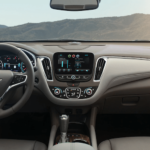Have you found the perfect Chevrolet car, truck, or SUV that meets all your needs? If so, it’s time to research Chevy lease deals and financing opportunities. But what does it mean to lease a car? A lease is like “renting” a vehicle rather than buying it. A lease offers drivers the option of driving a new car without large monthly payments; however, at the end of the lease, ownership of the vehicle does not transfer to the driver.
Leases are attractive to consumers who want lower monthly payments without the hassle of car ownership or who want to always be driving the newest vehicle on the market. Lease deals frequently change depending on the manufacturer and their incentives. But what exactly is a car lease, and how often do lease deals change?
What is Financing?
Financing a vehicle is a popular option among drivers and is vastly different from a lease. Drivers who choose to finance a vehicle take out a loan to pay for the car and then make monthly payments on that loan for a length of time. Once you have reached the end of the payment period, the car becomes yours officially. Financing is a great option for people who want to own their vehicle outright and for those who don’t plan to change cars frequently in the future.

What is a Lease?
Leasing a vehicle is more like renting rather than investing in a vehicle. Instead of paying a purchase price, you pay for the amount of depreciation the car goes through while driving it. Basically, you are paying for the value that the vehicle loses rather than the value it retains.
Leasing a car requires the driver to make monthly payments, but the payments are often lower and come with more limitations depending on the dealership and manufacturer. Most leases will have mileage limits and care requirements that must be met. Going over the agreed mileage or failing to do required maintenance will result in fees and penalties. These requirements are set in the lease contract, and the contract will usually last between two and four years or for a set amount of miles.
Rather than owning the car at the end of the lease, the driver returns the vehicle to the dealership. Some dealerships offer drivers a purchase option at the end of the lease, where you can buy the car for the rest of its value, but this isn’t always offered. Drivers may also opt to lease another vehicle if they remain in good standing, have made their monthly payments on time, and meet the requirements of a new lease.
Types of Leases
There are two types of leases with their own requirements, benefits, and risks: open-end and closed-end. An open-end lease is the more flexible option of the two. In an open-end lease, the future value of the car is not listed in the contract. This can yield a refund at the end of the lease if the vehicle is worth more than anticipated, or it could require the driver to pay an additional amount if the vehicle is worth less than anticipated. As the lessee, you take on the risk, but your terms will be far more flexible.
In a closed-lease, drivers do not have to worry about the value at the end of the lease because the amount will be agreed upon in your contract. Here the dealership takes on the risk because if the value is worth less than anticipated, you do not have to pay them any extra. However, because the dealer is taking on the risk, they will make your lease terms more strict and will impose fees if you break any of these terms. For example, you can expect fees if you go over the agreed mileage limit or have put excessive wear on the vehicle.
The type of lease you get depends on the dealership. You will most likely be given a closed-end lease at a consumer dealership because this provides predictable payments and fixed terms. Open-end leases are more common for businesses that use vehicles that take a lot of miles or need flexible terms.

Chevy Lease Deals
Most manufacturers offer new lease deals every month, with incentives improving closer to the end of the year when dealerships try to move inventory to make room for the next year’s models. That’s certainly the case for Chevrolet, with their lease deals frequently changing depending on the season and the manufacturer’s incentives. So, what do Chevy lease deals typically look like? Let’s look at some examples of deals from November 6, 2020, to see what some of the lease deals look like at the time of writing this article.
Drivers interested in leasing the 2020 Chevrolet Trax FWD LT reap the benefits with Chevy’s latest ultra low-mileage lease options. Leases like this are usually pretty nice at first glance and are a perfect opportunity to jump on if you don’t need to drive the car around much. These deals can be local or national.
The Chevrolet Trax FWD LS is available to qualified lessees for $139/month for 24 months with $2,399 due at signing and $0 for a security deposit. You can also opt for the Trax FWD LT, a Chevrolet national lease offer, for $189/month for 39 months with $1,299 down and $0 security. Tax title, license, and dealer fees will be additional costs at the time of signing.
This seems like a great option until you look at the limited mileage aspect. The FWD LS deal has a mileage limit of 20,000 miles, and the FWD LT has a limit of 32,500 miles. If you don’t drive a lot, this is an amazing deal to take advantage of. If you do drive a lot, you will probably want to wait for a deal with a higher mileage limit. Going over the mileage limit of either of these leases will cost you $0.25 per mile, which can add up quickly if you aren’t careful.
Truck fans can also find some pretty good lease options for the Chevy Silverado, but this is where deals can get a little complicated. Lease deals will usually be offered for specific trims and drives like the Trax FWD LT and FWD LS deals. These deals can be linked to specific engines, configurations, and packages as well. For example, let’s look at some Chevy Silverado 1500 deals.
The Chevy Silverado 1500 Crew Cab 2WD Custom with 4.3L EcoTec3 V6 and Custom Value Package is being offered as a Chevrolet national lease offer. This lease is another ultra low-mileage option for qualified lessees. For $1,949 down and $229/month, you can lease this Silverado for 24 months and 20,000 miles.
If you want a different model, there is also a deal for the Silverado 1500 Short Box Crew Cab 4WD LT with 5.3L EcoTec3 V8 and All-Star Edition. This model will run qualified lessees $299/month for 36 months and 30,000 miles. You will owe $3,799 at signing and no security deposit. Don’t forget, taxes, title, license, and dealer fees will always be extra.
As you can see, there are a lot of ways lease deals can change. They can be drastically different between models in the same lineup and will often offer different terms. Don’t forget to look at the added fees and penalties for breaking them, like the $0.25 per mile over the limit you will owe for any of these low-mileage deals.
These lease examples from Nov 6, 2020, will be different for you if you are looking at leasing a Chevy for yourself, but we hope these examples will help you understand what a lease deal can look like. Be sure to ask your dealer what lease deals are currently available. Who knows, you may get an even better deal!
How to Determine if a Lease is Right for You
Now that we’ve covered the basics of leasing a vehicle as well as what a Chevy lease deal can look like, you might be wondering if leasing is the right option for you. While many drivers opt for traditional financing that allows them to take ownership of the car, leasing has become more popular over the last decade. If you only need a car for a short period, then leasing is a great option. Leasing also might be a better option for you if you don’t want the hassle of owning a car or want the opportunity to drive new cars as they come out. By leasing, you’ll get the best of both worlds—the perks of driving the latest models without the overhead of car ownership and long-term maintenance.



